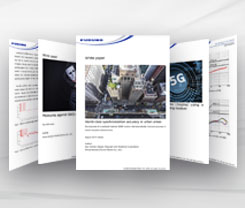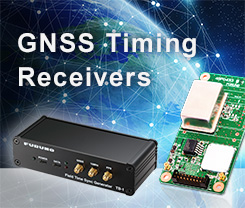Column
A Solo Journey
- The GPS (GNSS) Tracking System That Helped Kenichi Horie Cross the Pacific -
 Horie arriving after his crossing of the Pacific
Horie arriving after his crossing of the Pacific
At 2:39 a.m. on June 4, 2022, marine adventurer Kenichi Horie arrived in his beloved boat, the Suntory Mermaid III, at his final destination in the Kii Channel near Osaka Bay. He finished this solo and nonstop journey across the Pacific Ocean at the world`s highest age; 83 years old, arriving in Japan after 69 days departing from San Francisco, USA.
The Suntory Mermaid III, a 5.83-meter (roughly 19-foot) yacht, is the same size as the original Mermaid Horie used some years ago when he quietly departed from Japan on a previous solo trans-Pacific journey. It is said that crossing the Pacific Ocean in such a small vessel is as hard as traveling tens of thousands of kilometers across unpaved terrain in a tiny kei car, the smallest and lowest-powered class of Japanese automobile on the road. His latest successful journey across the ocean in the Mermaid III was a meaningful one for Horie, as it reminded many of the daunting crossing Horie completed 60 years ago.
Provision of a Tracking System and Safety Equipment
This time around, Horie's journey differed from that of 60 years prior in that, despite traveling alone, he had many people watching over him from afar.
"This is the third time we've provided support for a voyage by Mr. Horie," explains Atsushi Takagi, who is the general manager of FURUNO's Marine Electronic Products Division Products Planning & Marketing Department. FURUNO ELECTRIC CO., LTD. provided the GPS tracking system and safety-related equipment used on Horie's latest trans-Pacific journey.
"Mr. Horie first talked to us about this voyage in 2020," continues Takagi. "He told us, 'I want to make the same journey I did all those years ago, using the same small yacht. I won't be needing an anemometer [used for measuring wind speed and direction], as I can gather that information well enough on my own. Just give me the minimum required equipment.' He didn't plan on taking a generator, either, so our equipment would need to function using the limited electric power provided by solar cells. And it had to be robust enough to last the journey and require no maintenance. We didn't have any tracking system products at the time, so we had one of our veteran developers repurpose a custom product they had previously created for another purpose."
The tracking system unit was installed on the stern-side railing, and display units were on deck and inside the cabin. GPS positioning information was sent via Iridium satellite phone data feed to our server, and the intervals at which data would be transmitted by the system and other such settings could be remotely altered. According to Takagi, however, Horie was originally skeptical about the idea of installing a tracking system on his boat at all.
"He explained that he was the only one who needed to track his position, not anyone on land. He didn't want to bring excessive amounts of equipment, but after further consideration, he decided that using the tracking system was probably for the best."
Role of the Tracking System
 The course of the Mermaid III from San Francisco to the Kii Channel. A website set up to track Horie's progress from start to finish attracted tens of thousands of hits at the start and conclusion of his journey, as well as thousands of additional hits mid-journey. Countless people were tracking and watching over the sailor's progress.
The course of the Mermaid III from San Francisco to the Kii Channel. A website set up to track Horie's progress from start to finish attracted tens of thousands of hits at the start and conclusion of his journey, as well as thousands of additional hits mid-journey. Countless people were tracking and watching over the sailor's progress.
The Suntory Mermaid III tracking site can be viewed here.
Horie was on a daring sea voyage, not a pleasure cruise, so the possibility of danger had to be taken into consideration. There have been many situations in which having a tracking system onboard has helped sailors out of tough situations, and this was one of his main reasons for including the system on Horie's Mermaid III. However, it was conceivable that, if Horie were to become stranded somewhere and the tracking system informed others of his position, he might be in a location where rescue is impossible. As a supporter of his voyage, FURUNO was fully aware of this possibility.
"On land, Mr. Horie seems like nothing more than a sprightly, veteran yachtsman. He often joked that a Pacific crossing is nothing more than a short spin around the block," says Takagi. "However, like Mr. Horie, I also sail myself, so I am aware of how daunting a journey it truly is. He believed in his vessel and had full confidence in his skills, which I think is very impressive."
The yacht was equipped with a weather vane, which enabled positioning of the boat at a fixed angle relative to the direction of the wind. By using the weather vane in conjunction with the GPS to track vessel movements, it was possible for Horie to spend longer periods of time inside the cabin resting his body. During the journey, he also encountered some foul weather, and was also forced to take a winding course due to the effects of the Kuroshio Current, both of which presented big challenges. Throughout it all, the landside support team kept constant tabs on Horie's location in the sea, which was a big help.
A Night-light Illuminating the Way Forward
’Takagi continues: "During a special interview we arranged, held in celebration of his successful crossing and featuring Horie himself, he got everyone in the room laughing when he stated, 'I had thought about sneaking into port at Hawaii when I passed nearby, but that was impossible—I would have been found due to the onboard tracking system.’ In all seriousness, though, I was pleased to hear that our tracking system contributed to his journey in some way, and that he was able to put his trust in us."
One log entry during the journey serves as testament to that high level of trust.
"I only turn on the light in my cabin when I want to read a book. Other than that, the light from the GPS and compass, which are turned on around the clock, provide enough light for me."*
* Source: "On the Northern Edge of the Trade Winds," an April 4, 2022 entry in the voyage's log, Voyage of the Suntory Mermaid III (https://www.suntorymermaid.com/sm3/2022/04/04/sm3_0404_3/)
The GPS and other navigational equipment, provided Horie's current position and the course ahead, served as a night-light throughout his journey in his tiny one-person cabin full with food, supplies and other necessities. His log entry shows how, in one way, the equipment provided by FURUNO served to support Horie as he crossed the Pacific Ocean.
Writer introduction

Mr. Mitsunari Kita Science and technology writer
Born in Ishikawa Prefecture in 1964. Based on his experience in covering industrial technology, cutting-edge technology, and space development, he is passionate about unraveling and conveying difficult topics in an interesting way to people of all ages, from children to senior citizens. From 2009 to 2014, he was a member of the editorial board of "JAXA's," the official magazine of the Japan Aerospace Exploration Agency. Author and co-author of the following books: 『あなたにもミエル化? ~世間のなりたちを工学の視点から~』(幻冬舎mc)、『私たちの「はやぶさ」その時管制室で、彼らは何を思い、どう動いたか』(毎日新聞社)、『東京大学第二工学部70周年記念誌 工学の曙を支えた技術者達』(東京大学生産技術研究所) etc.,
* All registered trademarks used herein are the property of their respective owners.
Pick up
Column
FURUNO Column
-
Common Problems That Affect GPS/GNSS Time Synchronization

-
How to select GPS/GNSS antennas for time synchronization

Column by Mr. Mitsunari Kita (Science and technology writer)
-
The Observation Network Created by the Earthquake Proves Useful for Accurate Timekeeping (Part Two of Two) - A Solution to the "Mr. Higgins Problem" in Space -

-
The Observation Network Created by the Earthquake Proves Useful for Accurate Timekeeping (Part One of Two)

-
FURUNO ELECTRIC Joins Experts From Around the World on a Norwegian Island for Jammertest 2024

-
Unraveling the Mysteries of Venus Based on "Occultation"

-
Atoms as the Basis for Measuring Both Fleeting Moments and Near-Eternities

-
Time Progressing with a Speed Difference of Just 4.4647 Ten-Billionths!

-
Critters Who Revitalize Forests Through the Spreading of Food Caches

-
Small But Significant Variances in Gravity and Time (Part Two of Two)

-
Small But Significant Variances in Gravity and Time (Part One of Two)

-
Why the GT-100 Time-synchronization GNSS Receiver Module is Like Fragrant Soup Curry

-
What Rainbows Can Teach Us About Dual-Band GNSS

-
The Amazing Things That Are Possible With Just a Clock

-
When Subterranean Earth Meets Outer Space

-
Using the TB-1 and GT-100 at a "Multipath Dojo" in the Major Metropolis of Osaka

-
The Disaster-struck Field Time Sync Generator TB-1: True Performance Revealed Through a Lightning Strike

-
Knowing the "Now" of Our Earth Through GNSS

-
The Reason GPS Counts Time in 1.5-second Intervals

-
Similarities Between "On My Count!," the 117 Notification System, and GPS

-
Reliable Clocks Help Us Find a Silver of the Clouds

-
Why Time Synchronization is Vital for Criminal Investigations, Seismograph Measurements and Solar Wind Observation

-
What Was "Cesium" About Cesium Akina?

-
Updating Analog Broadcasting with GNSS Time Synchronization Technology

-
The Long History of One Second (Part II)

-
The Long History of One Second (Part I)

-
A Solo Journey - Three-liter Microsatellite Mission Support via GPS (GNSS) and Satellite Communication -

-
A Solo Journey - The GPS (GNSS) Tracking System That Helped Kenichi Horie Cross the Pacific -

-
The Day After a Superflare - Effects on power and wireless communication infrastructures -






